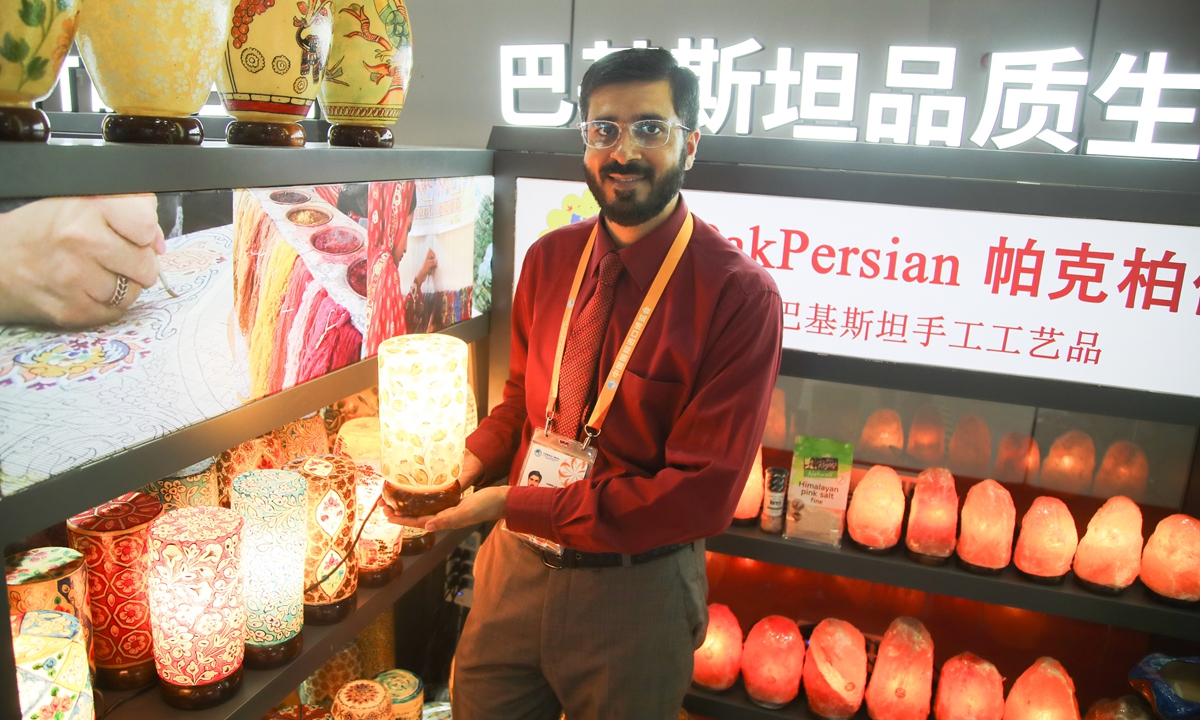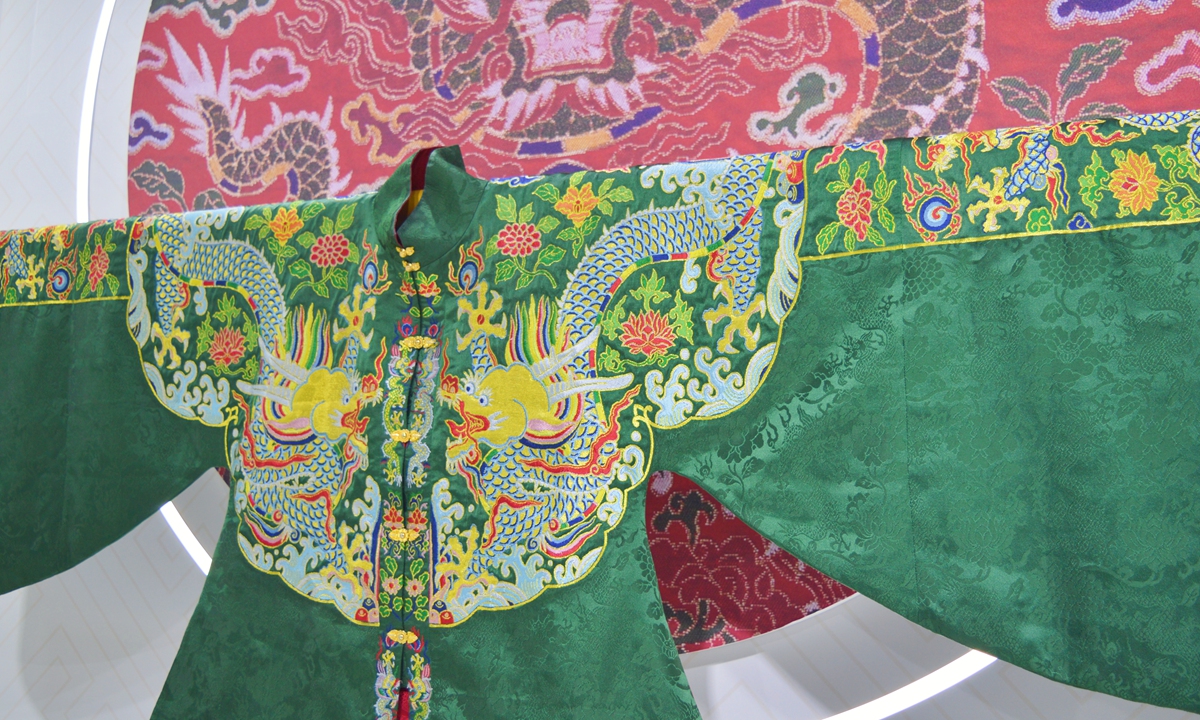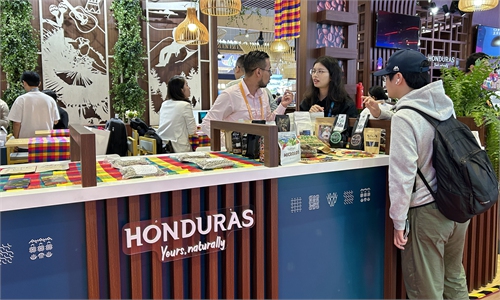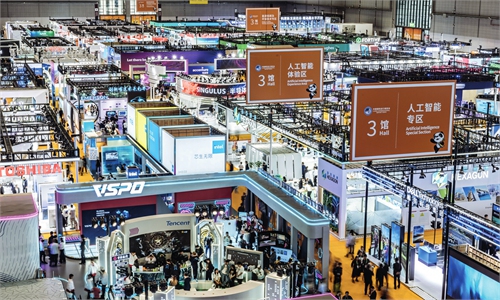
A man displays Pakistan's camel leather lamp at the CIIE in Shanghai. Photo: IC
As a melting pot of international resources from 154 countries and regions around the world, the ongoing 6th China International Import Expo (CIIE) in the Chinese mega city of Shanghai stages one of the most prominent global commerce galas in 2023 to be hosted by China.
Encompassing six themed display areas such as "food and agricultural goods" and "technical equipment," the CIIE in Shanghai is indeed gravitating toward business consumption. Yet, with the appearance of assorted Chinese Intangible Cultural Heritage (ICH) treasures and blockbuster artworks scattered in a 3,000-square-meter space, the CIIE is simply not just about "commerce," but is also a platform with a mission to promote diverse Chinese cultures to the world.
East meets West
Shanghai, as the current CIIE's host, is a city in which East meets West, with a combination of local traditions and a fusion of global cultures. To better introduce its Chinese characteristics to international traders, a "Shanghai ICH living room" has been installed at the CIIE's news center.
The space has on display a total of 117 ICH projects, including exquisite handicrafts such as enamel vases and purple clay sculptures, whose workmanship has been inherited by the city's local craftsmen for generations. As part of the local culture, ICH delicacies like Shen Dacheng sticky rice balls with a history of 148 years were also provided for visitors to taste.
Zhu Jingbo, deputy director of Shanghai Mass Art Center, told the Global Times that the "living room" is used to not only show the development of Shanghai's folk arts and crafts , but also intend to show to the audiences how such time-honored local traditions continue to thrive at present day.
Whether a fashionable accessory design inspired by the traditional silk tapestry weaving technique of kesi, or a purple clay pot incorporating a cute cartoon rabbit, the 20 sets of creative cultural products displayed in the booth showcase a contemporary evolution of style blended with old traditions.
Yao Yu, a creative cultural industry expert, told the Global Times that such new ICH products can "emotionally draw overseas visitors closer to traditional Chinese culture." Compared to the "collection" and "pricy" nature of traditional ICH products, those creative cultural items can build closer connections to people's daily life while they use them and gift them to others.
The "Shanghai ICH living room" is a regular agenda to the CIIE. Prior to the current show, a total of 710 local ICH treasures have been displayed at the CIIE since 2018 when the gala was first held in Shanghai.
"The goal of setting the area is to bring classic ICH legacies into modern life and make people feel their presence in life," Zhu told the Global Times.
Other than the "Shanghai style," the CIIE is also crowded with cultural legacies from other Chinese provinces and cities. To promote its distinctive ethnic minority culture, Yunnan Province has brought items such as paper cuttings unique to the people of the Yi ethnic minority group, and the exotic Shangri-La incense.
As a signature ICH legacy of Nanjing, yunjin brocade is on exhibition at the Jiangsu Province booth. Presented by the Nanjing Yunjin Brocade Research Institute, an ancient style garment called jifu (lit: garment of prosperity) with yunjin brocade patterns has intrigued international visitors.

A garment with yunjin brocade patterns on exhibition at the CIIE in Shanghai Photo: Courtesy of Nanjing Yunjin Brocade Research Institute
He Guanyi, a staffer of the institute at the CIIE, told the Global Times that he has greeted many visitors wishing to take a photo with the yunjin brocade designs. An exhibitor who specializes in the precision machinery industry commented that he was able to see the special wisdom and ingenuity of the Chinese civilization through the ICH treasure by comparing it to Germany's expertise in making "repetitive" and precision-prioritized inventions.
"We cherish the opportunity to showcase this legacy on an international platform like the CIIE. We want more international visitors to see the beauty of China through yunjin," Jian Mingwei, head of the institute told the Global Times.
In the China Pavilion at the CIIE, an installation called the Taihu Stone created by artist Qian Lihuai intrigued Samheng Bora, Secretary of State of the Ministry of Commerce of the Royal Government of Cambodia. The installation has been shaped like a stone despite being made of the bamboo. The work was presented by the Joint Laboratory of Digital Cultural Trade. The unique bamboo artwork is also part of the Chinese ICH treasures, which has thrived in Zhejiang Province.
Cultural sociologist Xu Shuming told the Global Times that such ICH treasures showcase Chinese cultural diversity as the CIIE also carries the mission of promoting such diverse Chinese cultures.
"Due to diverse cultural backgrounds, international visitors have some very unique viewpoints on China's ICH. In my eyes, I think their opinions can also inspire Chinese inheritors and exhibitors," said Xu.
'A new mode'
The culture-sharing platform is also open to overseas exhibitors to showcase their own cultural legacies. An exhibitor from Pakistan, for instance, has brought the camel leather lamp to the Chinese gala. Such craftsmanship has a 900-year history, but there are only 60 people in the country who can make it.
"China also has a long tradition of making leather handicrafts. The display of the precious Pakistani art might open new collaborative opportunities between Chinese and Pakistani craftsmen," Xu said.
Being imported through China's supportive "free tax display trade" term, the 6th CIIE has a section dedicated to "culture and arts" in particular. Top-notch artworks by masters such as French Fauvist movement pioneer Henri Matisse, contemporary Japanese artist Yoshitomo Nara, and Chinese master Zhang Daqian were also shown at the event for the first time.
"We are exploring a new mode of customs regulatory services that is compatible with the development of international high-end art and culture trade in order to reduce exhibitors' time and capital costs through policy support and services," said the deputy customs director at the Waigaoqiao Free Trade Zone.



